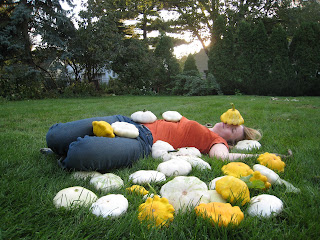 |
| Just think of them as big delicious seeds... |
In addition to chickens, another theme that FREQUENTLY surfaces in these books is seed-saving. I have read descriptions of how to collect and preserve the seeds of various plants, how to create my own breed of fantastic tomato, and generally how awesome, advisable, and easy it is to save your own seeds.
So last year I decided save a couple of easy seeds, just to try it. The first seed I collected was from my nasturtium plant. (nasturtiums are a lovely, peppery edible flower that I highly recommend. They are beautiful in pots as they will spill over the side and bloom profusely all summer long.) The plant itself actually suggested the idea when it turned up with loads of big green and tan seeds all over the place. Of course many seeds are so small that seed-saving would be a detail oriented activity, but nasturtium seeds are bigger than peas and hard to miss. I was not sure how to save them, or which to save (green or tan?), so I just put them all on a cookie sheet and let them air dry for a month.
The other seed I saved was from one of my Winter Luxury Pie Pumpkins. It was my first year growing this particular pie pumpkin, but it was easy to decide that this was my new favorite pumpkin. From just two plants I harvested more than 20 nice-sized pumpkins. The flesh was sweet and delicious AND the rind was soft enough to easily peel the pumpkins for one of my favorite recipes. Also, pumpkin seeds are another type of seed that is easy to locate, identify, and handle!
**this recipe looks and perhaps sounds a little unusual, but my friends, just try it.**
I rinsed the seeds out of the pulp, and again, just spread them out to dry for a month. After that, I stored both types of seeds in paper envelopes (not plastic bags, as I wanted any remaining moisture to be able to easily escape, and not cause mold or rot).
Truly, I expected this experiment to be straightforward, easy, and successful. Instead, the results were surprising and funny.
NASTURTIUMS
The seeds were in a variety of states when I collected them, from juicy spring green, to attractive dry tan, to desiccated dark brown. I didn't know what they were supposed to look like, so I planted some of each in my sprouting pots, as as far as I could tell they ALL sprouted. So far so good! I had lots of extra seedlings, which went to the gardens of my friends. Three plants made it into my garden; they grew at a healthy rate and then bloomed. And this is what happened:
They grew in three different colors! The mother had only orange flowers, but here you see the technicolor evidence of the genetic forbears of my original plant. Fun! All the flowers were perfectly tasty, so this experiment in seed saving was perhaps even MORE successful than I hoped, as it came with a delightful color twist.
 |
| Feathery marauders interrupting the floral photo-shoot. Nomnomnom |
PUMPKINS
Woe. Woooeeee is meee. WOOOOE!!
Oh, I get emotional when I think about my poor pumpkins.
The seeds I saved were from one of these pumpkins:
 |
| Winter Luxury: beautiful tender orbs of golden sweet flesh. |
When the seeds I had saved sprouted and grew, I thought things were going great. But as soon as the first fruits started to grow as odd yellow things, I knew something was amiss. When I realized what had happened, I was floored. My old nemesis, scallop squash, had one final trick up its sleeve. This squash was almost the end of me last year:
 |
| If the seed catalog says a plant is "prolific," it might be a warning, not a promise. |
My beautiful pumpkins were pollinated by SCALLOP SQUASH!!! And the alien yellow blobs laying all over the grass were their unholy offspring. They were just as prolific as BOTH of their parents, and truly, if they had turned out to be edible, all would have been forgiven. I waited optimistically until fall to bake one up. It was disgusting. Inedible.
 |
| This squirrel disagrees. Bon appetit, squirrel. And yes, my squirrels are black. |
So here are my conclusions on seed-saving:
1-I think very few of the people writing these crunchy granola homesteading books have actually TRIED seed-saving. I think they are reading each other's books, and thinking "AH, what a lovely crunchy granola idea! I would be remiss if I did not mention it in my book as well!" without ever bothering to try it. I think in fact they order their seeds from rareseeds.com like every other crunchy granola homesteader.
2-The reason for this is that in a home garden, even a big one, there is no conceivable way to control who pollinates who. I had heard stories of zucchinikins and pumpkinicumbers, but like a trusting parent, I thought it would never happen in my yard. Don't be blind, gardeners, those frisky plants are all over each other.
3-I still think saving flower seeds is a nice idea, because much less can go wrong. If you take my advice and somehow end up with a flower that is ugly and smells bad, please let me know so that I may amend my position.
If you have a seed-saving experience to share, please leave me a comment!




























































